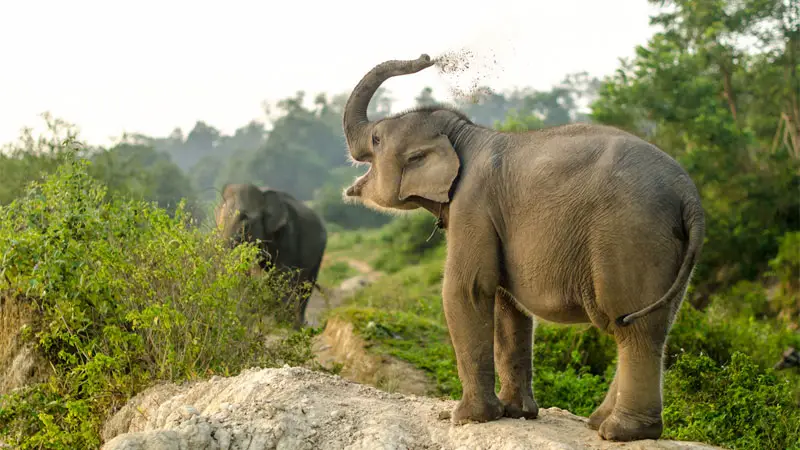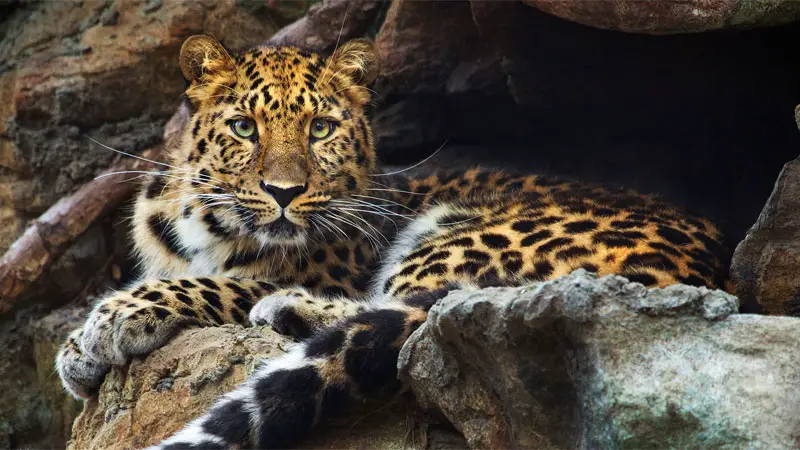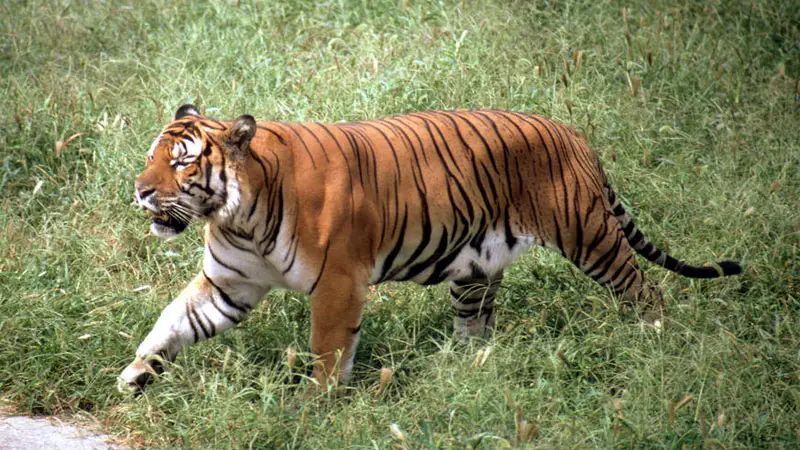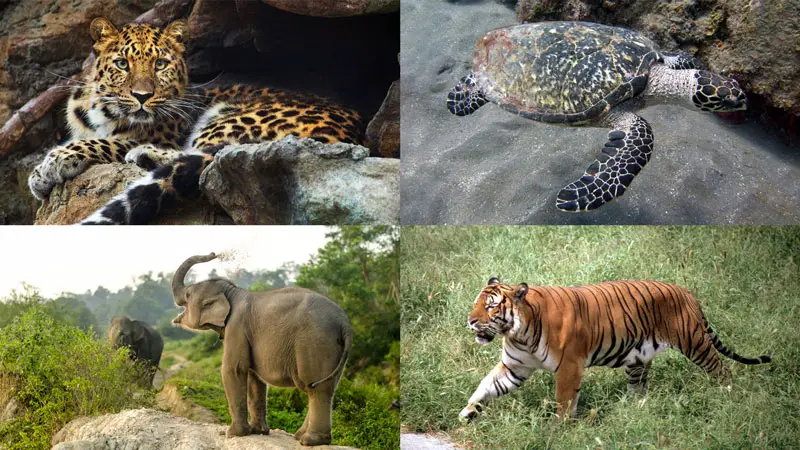Excessive of urbanization, industrialization and deforestation may eventually make much of the entire animal world endangered. Animals do not only make this world look beautiful but they are also needed for the survival of humans and fulfill their basic necessities in life.
Some animals are used as food to eat, some of them give milk to drink, and some of them are for the purpose of providing medicine. Many are even seen as companions to human beings.
Currently, a large number of animals are endangered or at the risk of extinction including mammals, reptile, birds, insects, etc. There are also some of species of animals have already disappeared from the various ecosystems of this world.
The reason could be anything such as, deforestation, climate change, extreme poaching, etc. If, all species of animals slowly and gradually start vanishing from this planet, it would be very difficult for human being to survive solely in this arena.
Types of Endangered Animals
1. Sumatran Elephants

The Sumatran Elephant is subspecies of elephants. It is considered the biggest mammal on the island called Sumatra. The size of a Sumatran elephant is up to five tons in weight and almost reaches nine feet in height.
Sumatran elephants are prominent as herbivores in nature. They used to munch up to 350 lbs of plants in each day. That is almost the weight of two human males. The life span of them is from 55 to 70 years.
These subspecies of elephants are likely to roam in the forests of Sumatra. The island of Sumatra is located in Indonesia. It also contains huge amount of animals and plants. The Sumatran elephant is one of them.
Sumatran elephants have a small number of predators or enemies. It is because of their size that restrains other animals from attacking them. However, on the odd occasion, a tiger will prey on the babies of Sumatran elephants.
Sadly, the species of Sumatran elephants are among the most endangered animals or at the risk of being extinct from this world. The number of Sumatran elephants remains around 2400 -2800.
Increases in human population and the need for land for them are the main drivers of tropical forest loss. This has caused a 69% habitat loss for Sumatral elephants during the period from 1980 to 2005. That is huge!
2. Amur Leopards

Amur leopards are species of leopard and a type of mammal. They are carnivores that eat deer, wild pigs, badger, etc. They also on occasion can attack a young black bear as a meal.
Amur leopards are the only species of leopards that have ability to survive in both extreme snowy winter and hot summer seasons. They live in the region crossed by the Amur River, a natural boundary between Russia and China. They are one of the fastest creatures and are able to run up to 35 miles per hour.
Like other animals, these subspecies of leopard are also at the risk of extinction. In the case of Amur leopards, there is a hope that they can be saved from their complete disappearance.
It is because of Russia who has already taken steps including the presence of anti-poaching teams, production of plants, and tracking of populations that ensure land development consider Amur leopard habitats. As a result, the population of Amur leopards has almost doubled from 30 in 2007 to 57 in 2015.
Read Also: 18 Different Kinds of Hedgehogs
3. Hawksbill Turtles

Hawksbill Turtles are a species of turtle and are a type of reptile. They are omnivores in nature. The duration of their lives is around 30 to 50 years. The size of a Hawksbill turtle is estimated about 30-35 inches in length and 90 to 150 pounds in weight.
There are only five species of turtle that exist worldwide. Almost eight-hundred turtles in their totality are made up of them. Hawksbill turtles are mostly found at warm places like tropical waters of world’s oceans including the Pacific Ocean, Atlantic Ocean, and Indian Ocean.
Unfortunately, this beautiful creature of God is counted among the most endangered animals and is the 4th most endangered animal overall. Hawksbill turtles are excessively and brutally hunted and are being sold illegally on the black market.
They are used to create ornamental products and valuable jewelry. Japan is among the countries that use Hawksbill turtles a lot in terms of making such products. For instance, they use turtles in making their wedding dresses as it is a traditional culture of Japan for 300 years.
See Also: 4 Types of Coral Reefs
4. Tigers

Tigers belong to one of the groups of mammals. They are carnivorous animals (eat other animals or prey others as food). Tigers are considered in the same family as cats and are prominent for being strong, powerful, and scary predators to other animals.
There are still some subspecies of tigers that exist but are at a great risk of vanishing soon. Some species have already disappeared from this land, sadly.
The following existing species are: Bengal Tigers, South China Tigers, Indonesia Tigers, Sumatran Tigers, Amur Tigers and Malaysian Tigers. The species of tigers that have already vanished are: Caspian Tigers, Bali Tigers, and Javen Tigers.
The species of tigers are often found in the far east (specifically in South East Asia and Asia as whole). India, China, Russia, Bangladesh, Malaysia, Indonesia, Thailand, and Nepal all have species of tigers that can be found.
Tigers are animals that prefer to live in an area with dense covering like forests with access to water and plenty of prey of animals for food as well. They usually travel a long ways to prey on a variety of animals including buffaloes, boars, and deer among others.
They do not believe in wasting food they hunted so they cover the remaining food with leaves and come back the next day for another meal.
When the age of females (also known as tigress) reach around three to four years and the male tigers reaches around four to five years, they become mature enough to breed. There is no particular season needed for them but they usually prefer the cold season to mate (from November to April).
It is the tigresses who signal tigers and let them know that they are ready to reproduce by vocalizing and marking their territory with distinct smelling urine.
After mating, each tigress has ability to give birth to more than one young (at least two to six cubs at the same time) in the period sixteen months. The tigress rears her cubs for almost two to three years, afterwards they disperse to find their own territories. Male tigers have nothing to do with the growing process of cubs.
The young cubs start learning to hunt at an early age of around sixth months. They gradually being competent in their 11th month and eventually they become fully independent at the age of around 18 months.
Tigers are among those animals that are deemed as endangered animals. Some subspecies of tigers have already disappeared due to illegal poaching and deforestation. Currently, tigers are fewer than 4,000 left in the wild.
In 2014, China explicitly outlawed the consumption of endangered species including tigers, whose bones and other organs are superstitiously believed to have magical curative power. If this continues, it will cause great danger to the kingdom of animals.
Conclusion
The above-mentioned animals are a few examples have been taken from the list of most endangered animals. If human beings really want to survive and preserve this beautiful planet, then they have to take some steps in favor of animals and others species to protect them from vanishing completely. Like Russia has already taken good efforts to protect species of Amur Leopard.

